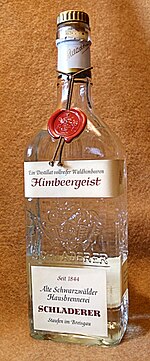Himbeergeist

Himbeergeist (lit "raspberry spirit", also known as raspberry spirit obtained by maceration and distillation,[1] eau de vie de framboise[2] or simply framboise[3]) is a geist (type of fruit brandy or Schnapps) made from raspberries. It is produced mainly in Germany and the Alsace region of France.
Rather than being distilled into liquor from a fermented mash of fresh fruit like a fruit brandy (Obstler in German), Himbeergeist is made as an infusion.[4] Because raspberries' low sugar content can produce only a limited amount of alcohol, Himbeergeist is created by macerating fresh berries in 95.6% pure neutral spirits.[5][6] The mixture is then steeped for several weeks to draw out the raspberry essence, distilled, diluted with purified water, and bottled at 40% ABV or stronger.
It takes about 17 pounds (7.7 kg) of raspberries to produce one liter of Himbeergeist.[7]
See also[]
- Brandy
 Liquor portal
Liquor portal
References[]
- ^ "Consolidated text: Regulation (EU) 2019/787 of the European Parliament and of the Council of 17 April 2019 on the definition, description, presentation and labelling of spirit drinks, the use of the names of spirit drinks in the presentation and labelling of other foodstuffs, the protection of geographical indications for spirit drinks, the use of ethyl alcohol and distillates of agricultural origin in alcoholic beverages, and repealing Regulation (EC) No 110/2008". 25 May 2021. pp. 49–51.
{{cite web}}: CS1 maint: url-status (link) - ^ Anderson, Susan Heller (26 August 1984). "Alsace's Eaux de Vie Pack a Fruity Punch". The New York Times.
- ^ Asimov, Eric (15 August 2007). "An Orchard in a Bottle, at 80 Proof". The New York Times.
- ^ "Directive 110". 15 January 2008.
on the definition, description, presentation, labelling and the protection of geographical indications of spirit drinks and repealing Council Regulation (EEC) No 1576/89
§17 - ^ "Spirituosenlexikon". Die Schnapsbrenner (in German). Archived from the original on 10 April 2008.
- ^ "Fachlexikon". hoellberg.de (in German). Archived from the original on 9 October 2007.
- ^ Virbila, S. Irene (22 April 1990). "Eau-de-Vie, the Spirit of Alsace". The New York Times. Retrieved 21 November 2021.
- Fruit brandies
- Distilled drinks
- German words and phrases